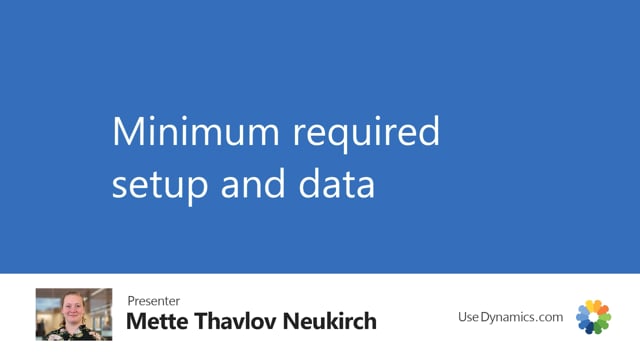
Playlists Manage
Log in to create a playlist or see your existing playlists.
Log inIf you’re new in using the app or want to check that you’ve made everything correct, it might be relevant to look at this list of minimum required setup and data.
So the need-to-haves are the subscription setup, which you actually go through in the wizard that you open when you install the app. And here you set up some rules for calculation of end dates and the number series, so the system knows how to number the subscriptions and the documents related to subscription invoicing. You also need customers, because you’re not allowed to create a subscription without a customer, so you need at least one customer. And in some other videos I’ll show that you can create a dummy customer if you want to create some templates. And then of course you need to create subscriptions. And this includes the subscription header and the subscription lines, so the whole subscription that you see when you open a card, you need the information on the customer, and then you need to create the lines that are actually invoiced. The orange ones means that you’re here working in the app. The blue color means that it’s a standard Business Central table, and you probably already have customers if you’ve been using the system for a while.
But yes, I mentioned you need at least one customer as a required setup to start using the app. I normally also recommend that you create items, because then you can set up dimensions and other information that will be inherited when you choose that item into your subscription. So when we choose the item on our subscription, it will inherit both the item name and the dimensions that are set up on the item, etc. So that can save you time when you create the subscriptions. Of course, you can also post on a type G/L account, and then you won’t need to create items, but it usually saves time. Just remember to make sure that the type is correct, so you don’t create an item with inventory, but remember to mark it as a service item, which is usually the case for subscriptions.
If you do use items, you can also create sales prices and discounts, which again just saves time when you add the item, and the subscriptions will follow your general setup for sales prices, etc. Because as you can see, all of these four are blue. So the same goes for deferral codes. If you want to add a deferral code on your subscription line, of course, you need to have created that setup for how the system should defer and which text it should write and everything like that.
And lastly, dimensions are important in most organizations, so we can have good reporting. You can set up the dimensions on the customer to be inherited from there or on items or on a G/L account, and most companies use dimensions, so you probably have them already, but again, it’s usually a good idea to add them onto your subscription so you can get a department dimension or whatever you need in your reporting.

